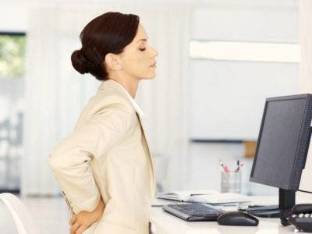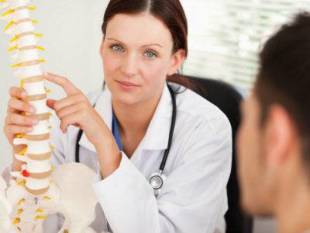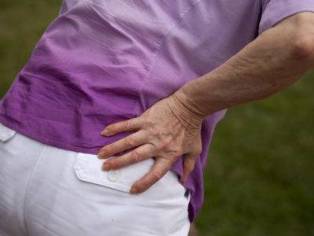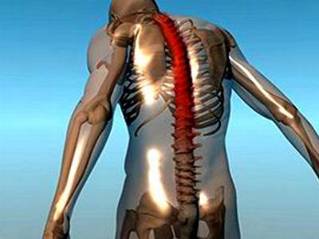If the person experiences back pain in the lumbar area, the reasons can be different up to the renal pathology. Often this symptom is due to disease-lumbar-part sacrum of the spine. Lumbar is a mobile phone which becomes the most frequent cause of injury in this area.
Why develops the pain syndrome?

The back pain is only a symptom. The acute pain in the lower back, related to the violation of work of the lumbar vertebrae and the disk is called low back pain. Why it hurts your back at the bottom, the whole world should know. We distinguish the following causes of appearance of this symptom:
- the osteochondrosis lumbar-part sacrum of the spinal column;
- the hernia between the vertebrae;
- the disease behtereva;
- the displacement of the vertebrae;
- congenital defects of development (the presence of the extension of the lumbar vertebra, the division of the pin);
- congenital disorder of the form of the vertebrae;
- benign tumors, malignant tumors, and vascular tumors;
- the rheumatism;
- the inflammation of the back muscles (myositis);
- the inflammation of the sciatic nerve;
- the fracture of the spinal column;
- spondylolisthesis;
- osteomyelitis;
- fibrotic;
- osteoporosis;
- protrusion of the unit;
- the narrowing of the spinal canal;
- osteoarthritis;
- the disease of the kidneys (mild hydronephrosis, pyelonephritis, tumors).
The spine in the lumbar area may be sore the result of simple muscle spasm. This is possible if you are touring or performing sports activities. The back pain in the lumbar area more common in people who lead sedentary lifestyle and rise of gravity. People involved in sporting activities, this pathology is much less.
Lumbar-kresttsoviy the osteochondrosis
If you constantly hurt the waist from behind, then it can be a manifestation of the degenerative disease of the lumbar disc-part sacrum of the spine. It is a disease in which the involvement mainly of the discs between the vertebrae. Is thinning, which leads to friction between them and the reduction of the mobility of the unit. Are identified the following predisposing factors are the development of this disease:
- stay for hours in an uncomfortable position;
- long inclinations of the trunk;
- the lack of training in the practice of physical education;
- the weakness of the muscles and ligaments of the back;
- the use of backpacks-in-1 strap;
- the presence of flat feet;
- heavy duty;
- the higher static load;
- improper organization of the workplace.
Back pain is the main symptom of degenerative disc disease. With 1 degree of the disease pain syndrome does not exist. The development of the propeller of the unit is developed low back pain. This suddenly appears a pain in the lower back. Some people feel like an electric shock. She appears when there is an abrupt change in posture or movement.
If you suffer from back pain in the lumbar area, it may be due to lumbodynia. Chronic pain is the osteochondrosis. Its appearance is not dependent on the motor activity of the person. The pain is that it hurts. This people is difficult to bend the body. In the position of the person in a supine position with syndrome pain disappears or decreases.
The osteochondrosis 3 degree develops radicular syndrome. Manifests lumborum ischialgia. It is a pain that occurs in the lower extremity to the toes. Often it is combined with the violation of the sensitivity. The discomfort in the lumbar area conditioned compression of nerves, blood vessels and muscle spasm.
Symptoms of hernia

If you are bothered by pain in the low back, the causes can be due to intervertebral hernia. This is a very common disease. When it core of the unity of the vertebra moves. Often, in the background of this occurs a jump of the fibrous rings. The morbidity rate is 150 cases per 100 thousand people. We distinguish the following possible causes of the formation of a hernia:
- injuries (bruises, falls);
- the osteochondrosis lumbar-sacral of the division;
- the excess of weight;
- the curvature of the spine;
- closed curves.
In the group of risk are the drivers and the officials working in the team. The pain of the hernia has the following features:
- is local;
- often given in the thigh, the buttocks and the legs;
- it combines with other symptoms (numbness, tingling);
- intensifies during physical exercise.
The intensity of the pain syndrome is defined by the magnitude of the hernia. If it is large, you can develop a radiculitis. Manifest sciatica. It is an intense pain in the form of lumbagoes.
The majority of patients hernia develops pain because of the type of low back pain. Additional symptoms of the hernia is the decline in the power, the limitation of motion lumbar spine, weakness in the legs. Sometimes it breaks the flow of urination.
The symptoms of ankylosing spondylitis
When it hurts the back and into the sacrum of the sphere, and the lower part of the back for a long time, you can suspect the disease behtereva.
It is a chronic disease, a systemic disease in which more often involvement of the joints of the spine. The exact causes of the development of this disease are not installed. We distinguish the following possible etiological factors:
- the inflammation of the organs of the urinary system;
- the supercooling;
- the lesions of the bones;
- hereditary predisposition;
- of the infection.
The disease behtereva occurs mainly young people from 15 to 40 years. This pathology is manifest in articular and non-articular symptoms. The back pain and stiffness of the spine is considered to be more an early symptom. The pain is felt in lumbar-sacrum department. In the early stages of it are expressed weakly. Its occurrence due to inflammation.
The pain is bilateral. Many people indicate that the pain syndrome, the brighter it is expressed by one side. It has a duration of more than 3 months and no go. The disease develops very slowly. The pain is concerned of these people, mainly in the morning. It is possible to your appearance, after a static load.
Mid-afternoon diminishes. Pain syndrome is intensified in a state of rest and disappears during the work time. In the phase of the heat, the pain occurs during the night and during work. In later stages develops radiculitis. Pain syndrome in the disease behtereva combined with a deterioration in the general well-being of the person, restriction in the chest, difficulty breathing, omission of head, pains in the muscles and in the chest. Often they are surprised with the eyes.
The disease of the kidneys

If you suffer from back pain in the lower back, it may be due to disease of the kidneys (mild hydronephrosis or pyelonephritis). The kidneys are located retroperitoneal. When the inflammation (pyelonephritis) back pain is the most frequent cause of complaint of the sick. This disease often reveals himself to the children and young people. Pyelonephritis often develops on the background of renal lithiasis.
The disease has an infectious nature. More bright flows acute pyelonephritis. It is characterized by pain in the lower part of the back, nausea, fever, chills, weakness, general malaise, frequent need to urinate. Often appear edema. The pain is often unilateral, dull, and constant. The irradiation possible to the area of the upper quadrant, the lower part of the belly and the belly button.
If there is pain in the low back, the causes can be due to hydronephrosis. It is a disease in which occurs the extent of kidney stones and the cups and the pelvis. Often, this pathology develops in young children. On the basis of the development of the hydronephrosis est violation of reflux of the urine, the incorrect operation of the valve and the occlusion of the urinary tract.
When the hydronephrosis appears a sharp pain in the back. She is irradiating. Occurs in the side a little above the bones of the pelvis. The pain is paroxysmal, reminiscent of renal colic. Syndrome pain is combined with nausea, vomiting, appearance of blood in the urine.
Signs of sciatica
If the strong pain of the spine in the lumbar area, the cause may be an inflammation of the sciatic nerve. This condition is known as sciatica. In the risk group includes persons of the third age. Sciatic (sciatica) often develops in the background of the intervertebral hernias, infectious diseases (influenza, malaria, tuberculosis (tb), osteoarthritis, foodborne illness. Often, sciatica pregnancy occurs.
The sciatica pain has the following characteristics:
- acute (dagger);
- permeates;
- intense;
- burning or stabbing pain;
- initially appears in the lower part of the back, and then down (it is top-down in nature);
- it is distributed in the buttock, the thigh and the leg;
- constantly worry about in the form of seizures;
- has a different effect;
- often unilateral.
The pain accompanied by tingling, numbness, and mobility problems, mental problems. Other symptoms of sciatica refers to the muscle atrophy, the violation of the sweating, dryness and thinning of the skin.
The plan of studies of patients
Not everyone knows what you should do if you suffer from back pain in the lumbar area. You should consult your doctor and get tested. May require the following studies:
- ct scan;
- the x-ray of the lumbar-part sacrum of the spinal column;
- The ultrasound of the kidneys;
- magnetic resonance imaging;
- electroneuromyography;
- Doppler ultrasound of the blood vessels;
- general and biochemical analysis of the blood;
- analysis of urine;
- cystourethrography.
Is subject to the inspection and palpation of the lumbar region and the spine. Requires consultation neurologist or vertebrologist. During the examination, the doctor assesses the mobility of the spine, reflexes, muscle strength, amount of movements in the extremities. Almost always the cause of back pain are diseases of the spine. They are easy to identify the image.
Curative interventions

If it is very painful to the back, the treatment must be directed at the primary cause of pain. Apply the following treatments:
- system of the drug therapy;
- the use of the pills for the pain in the form of gels and ointments;
- the physical therapy;
- the chiropractic;
- acupuncture;
- the lock;
- the surgery;
- Lfk.
Such patients should be going to the gym and comply with dietary protein. All exercises should have a high amplitude. If the back pain is a symptom of pyelonephritis, it is necessary to comply with bed rest, take pain relievers and antibiotics. The chronic inflammation advanced are assigned to diuretics. Of antibiotics, preference is given to types of fluoroquinolones and penicillins.
Additionally, we mapped the immunomodulators and vitamins. In the case of the development of the hydronephrosis may require surgical treatment. When the pain in the back of the sciatica apply analgesics (Analgin), the combined means, the nsaids. In severe cases require novocaine blockade. In the scheme of treatment include the massage, the gymnastics, acupuncture.
To eliminate the pain can be distraction therapy. Apply the ointment of bee or snake venom. When the hernia is shown nsaids, applying traction to the spinal column, massage, and therapeutic exercise. In severe cases, surgery is necessary. When the pain in the bottom of the sciatica treatment involves immobilization of the spine, the use of analgesics and intramuscular administration of anesthetic agents. In addition are assigned to the B-group vitamins (Combilipen).
Effective and physical therapy. When it detects a degenerative disease of the disc is shown kinesitherapy, massage, reception of analgesics, and physiotherapy. Always impose chondroprotectors. Of those patients need to move more-and less-to the time to perform standing or sitting. In the scheme of treatment include the quiroprctica and the lock. Therefore, the occurrence of pain in the lower back is a cause of treatment in the hospital.

























